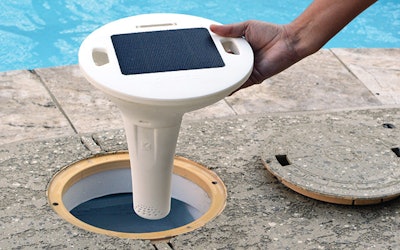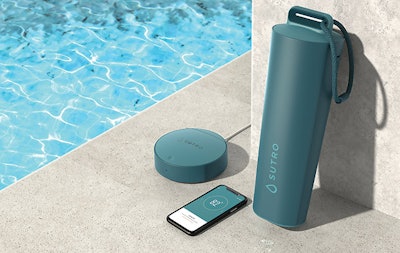
The IoT Movement is continuing to take America by storm. According to Statista, smart home devices — or internet-enabled devices that can remotely monitor and control areas of the home — are experiencing exponential growth, which is only expected to accelerate.
That surge speaks to a near-universal interest in products that shoulder the burden of home ownership and in many ways lessen the impact of life's annoyances. Instead of manually sweeping the floor, you can deploy a vacuum that cleans with the push of a button. A smart thermostat makes it easy to develop programming schedules to keep costs down and alerts you when maintenance is required. Even minor inconveniences, like waiting for toast to brown, can be eliminated with smart products.
It makes sense, then, that Silicon Valley developers have turned their attention to the pool. Next to cost, maintenance is a primary concern among pool owners. An IoT device making pool maintenance easier would surely find an immediate market.
The lucrative potential of such a device has spurred the development of several products that aspire to make balancing pool water more convenient. The most well known of these devices is pHin, the product that kicked off the smart water sensor movement. However, the field has rapidly grown with new competitors like Sutro, Keto, WaterGuru, Blue Connect and cFloat. And you can count on that list to only grow in the coming years.
RELATED: pHin: Here To Stay
Muddying the waters, so to speak, is a well-established truth: water chemistry is a difficult science. The approach to sanitizing and balancing pool water can differ from one pro to the next. And countless factors from pool environment to test interferences can throw off results, making the process of automating chemical treatment an uphill battle.
Is it possible to develop a device that can deliver the convenience homeowners seek with the accuracy professionals expect? Firms behind two new additions to the smart sensor market think they have cracked the code. Here, we talk to the developers behind these products about what's new, what's changed and what's just around the corner.
CATCHING UP, CATCHING ON
The story of the smart water sensor can be traced back to pHin, which began the smart sensor movement in 2014. ConnectedYard, pHin's parent company, has since reached two significant milestones: Lonza invested $7 million into the company, a move that gave the device — and the category as a whole — a big boost of credibility. Then, just last year, Hayward acquired ConnectedYard, making it the first of the Big 3 to make a significant play in the smart sensor category.
Another device, Sutro, made its debut around the same time as pHin. At the time, Sutro was quite similar to pHin in both design and intention: Both used ORP sensors in a floating device for chemical readings that were then communicated to an app, which provided chemical dosing recommendations.
But like countless startups, the company fell on hard times.
"Startups happen. Things get tough, things get tight," says Ravi Kurani, founder and president of Sutro Connect, Sutro's parent company. "... At some point in time we were not able to execute and the production schedule was just way too tight."
But that wasn't the end of Sutro.
"Obviously we had something there. So we went back to the drawing board again, we studied again, we erased everything on the board and wrote it all back up. And we're back with a vengeance."
The new Sutro model, which won recognition at last year's CES (a badge of honor for any startup), embraces a classic water testing technique. Through a partnership with LaMotte, the Sutro device contains reagents to conduct wet tests while in the pool, the results of which are communicated to the Sutro app.
RELATED: Sutro Announces Partnership with LaMotte
"Looking at reagent-based technology, it's been there for at least a hundred years. It's tried and true," Kurani says. "So we took that and basically built a platform and a system around it to be able to use the same exact chemistry that LaMotte, Taylor and Hach are using. We changed the way that sensing is done."
Richard LaMotte, vice president of LaMotte, says the company is interested in smart sensor technology like Sutro for its potential utility in its other markets, primarily aquarium hobbyists.
"We sell a lot to the aquarium industry, and to other industries," LaMotte says. "...There are a lot of applications that we could see this device morphing into, and that, to me, personally, is what I like about it."
 Sutro is the only device on the market that integrates wet testing into its methodology.
Sutro is the only device on the market that integrates wet testing into its methodology.
BRINGING BIG DATA TO POOLS
They say necessity is the mother of invention, an adage that rings true for Jeff Jensen. The former startup CTO purchased a home after successfully exiting a previous startup and, as a handy guy, assumed he could easily manage the water care. Like countless pool owners, he soon found he was mistaken.
"I usually only pay people to either change my oil or my garage door," he says. "But in the pool, I met my match. It was tough to take care of. So I went online and was like, 'Gee, this is kind of interesting, I'm a tech guy and I can't buy a device to take care of that for me.'"
That realization led to the development of Keto, Jensen's Houston-based IoT firm. The company's first release is Plainck, a solar-powered device that replaces the skimmer plate and monitors water from the skimmer basket.
In addition to its notably different design, Jensen says Plainck stands out for its ability to harness AI to provide a broader range of suggested actions.
"For me, purely monitoring the chemicals is not enough data to answer the whole question. There's a bigger question around the entire water management piece," he says. "So as a company — our product, our mission and our goal — I would describe us as a data company. And in order to be a data company, your data needs to be as versatile as possible to make the best decisions about managing a pool."
That data includes water chemistry parameters like pH, ORP, alkalinity and chlorine, like other devices. But unlike other devices, Plainck's stationary design enables it to monitor water level and motion, too.
RELATED: The Smart Pool Solution?
"Here in the Southern states we have a major issue with water management," he says. "We can evaporate up to 400 to 500 gallons a week in warm weather and when you refill with freshwater or it rains a lot, there's a lot more to the chemical monitoring story than just, 'Hey, I'm sensing the pH is high, let me go fix it.'"
The volume of data Plainck collects, Jensen says, can unlock an array of additional information about the pool. For instance, the water level sensing can help determine the presence of leaks — and even offer clues as to the severity of the leak. Jensen and his team have also learned to use data from the device to reduce pump runtime and, therefore, electricity bills.
"We've even been able to save some of our early users a small amount of money, $5 to $15 bucks a month on their electricity bills, because we can show you, 'Hey, your pool is still healthy and now you can bring down your total pump runtime and the data shows it's fine,'" he says.
FRIEND OR FOE?
By and large, industry professionals remain skeptical of smart water sensors. Some take issue with the methodology — for instance, manufacturers commonly recommend water samples be taken about 12-18 inches below the water's surface, a depth many devices at the waterline do not reach. (In Sutro's case, Kurani says the device is larger than other ORP sensors, enabling it to source water from about a foot below the surface.)
In addition, service techs who place chlorine tabs in skimmer baskets will find the practice incompatible with a device like Plainck. (Jensen says the company advises the use of floating chlorinators as they pose less threat to pool equipment compared to chlorine in the skimmer basket.)
Others are concerned about product quality and device maintenance that can be overlooked by homeowners looking for a set-it-and-forget-it device.
"We install equipment that's along the lines of commercial-grade chemical ORP and pH metering and dosing equipment on all of the pools we build. It has sensors on it that are extremely accurate, but they need to be cleaned every three to four weeks. And if you don't clean them, you end up with incorrect readings," says Dan Lenz, vice president of All Seasons Pools and Spas (Orland Park, Ill.). "The sensors we use are less expensive than many of the commercial sensors that are out there, but they're still about $150 bucks apiece retail. So we've got $300 worth of sensors alone monitoring pH and ORP, but a [smart water sensor] says you can do the same thing with a device that they're selling for $300. Something has to give somewhere."
Then there's the biggest worry: that these devices will ultimately hurt the pool professional by cutting chemical sales (which are among the most profitable revenue streams for retailers) and/or eliminating professional pool service from the pool ownership equation.
RELATED: Water Testing Made Easier
Kurani intimately understands this. He grew up in the pool business under his father and is well aware of the struggles a pool and spa professional faces. As such, he developed Sutro as a device that augments an existing water treatment program, but does not replace it.
"The sensor will give you pH, free chlorine and alkalinity in its current build right now. If you're going to open or close a pool, or if you have something that's a bigger problem, you're still going to need to go to a pool store," he says. "We're not replacing the pool store and the service technician.
"Think of this as like keeping healthy. You're going to go to your doctor's office to get that full-body checkup, but you may wear a Fitbit to give you that heartbeat. We're just the Fitbit."
Developers are also hoping to bridge the gap by positioning their devices as tools pros can use to better their businesses. Service companies that buy devices for homes on their route, for example, can monitor pools remotely and visit pools on an as-needed basis (and better prepare themselves for treatments before they arrive), allowing them to optimize their time and potentially make more money.
"Some service companies that we're working with are finding a new, improved business model," Jensen says. "They're shifting to an on-demand business model because they can proactively watch the pool from the office and efficiently route technicians based on immediate needs.'"
For its part, LaMotte is also keenly aware of the threat dealers feel from these products, which is why the company's partnership with Sutro stops short of a financial investment.
"We don't want to invest in something that's going to upset the marketplace," LaMotte says. "We value our dealers. We have easily 10,000-plus of our SpinLabs out there in dealers' stores across the country. We don't want to rock that boat."
MAY THE BEST DEVICE WIN
Seemingly overnight, the smart water sensor market boomed into a competitive industry. What changed?
"There's much easier access in the last two years to IoT technology, security, big data, cloud, that kind of stuff, than you've seen before," Jensen says. "So in some of these industries like pool and spa where there basically hasn't been much incumbent IoT technology, they can now catch up."
In terms of what's coming, Jensen predicts the industry will take cues from Hayward and start buying up devices.
RELATED: Technology: A Small Business's Secret Weapon
"You have these big companies that are now talking about IoT, remote monitoring and all this," he says. "The only downside for them is that organically, and I've just seen this from my previous startups, it's going to be tough for them to get off the ground. They know that getting things done organically is going to be tough because they're not inherently an IoT, cloud-based company.
"I think Hayward also set the standard that look, if you want to move fast and you want to be the leader in the pool industry, you need to find people who already know how to do cloud and build IoT-based products, and do it quickly."
For his part, Kurani is also unsurprised by the growing field of competition. And while he's cognizant of the lingering skepticism from industry professionals, he remains confident the smart sensor movement will only help the pool industry grow stronger.
"More competitors at first means more eyes on the space," he says. "I think that's a good thing, the fact that there are more players that see that this is a problem and there is a need, and people are trying to build solutions."










































